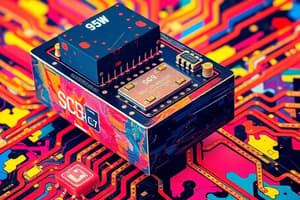Podcast
Questions and Answers
SINGLE PHASE FULL WAVE MIDPOINT CONTROLLED RECTIFIER: Explain the operation and characteristics of a single phase full wave midpoint controlled rectifier.
SINGLE PHASE FULL WAVE MIDPOINT CONTROLLED RECTIFIER: Explain the operation and characteristics of a single phase full wave midpoint controlled rectifier.
The single phase full wave midpoint controlled rectifier operates by controlling the firing angle of the thyristors to regulate the output voltage. It provides better controllability and higher efficiency compared to uncontrolled rectifiers. The characteristics include the ability to control the DC output voltage by varying the firing angle and reduced harmonic content in the output waveform compared to uncontrolled rectifiers.
What are the advantages and disadvantages of a single phase full wave midpoint controlled rectifier compared to uncontrolled rectifiers?
What are the advantages and disadvantages of a single phase full wave midpoint controlled rectifier compared to uncontrolled rectifiers?
Advantages of a single phase full wave midpoint controlled rectifier include improved controllability, higher efficiency, and reduced harmonic content in the output waveform. Disadvantages may include increased complexity and cost due to the need for control circuitry and the requirement for a triggering circuit for the thyristors.
How does a single phase full wave midpoint controlled rectifier differ from other types of controlled rectifiers in terms of operation and applications?
How does a single phase full wave midpoint controlled rectifier differ from other types of controlled rectifiers in terms of operation and applications?
A single phase full wave midpoint controlled rectifier differs from other types of controlled rectifiers by using a center-tapped transformer and two thyristors in a bridge configuration. This allows for the regulation of output voltage and better controllability. It finds applications in variable speed drives, DC power supplies, and renewable energy systems due to its improved efficiency and controllability.
Explain the working principle and circuit configuration of a single phase full wave midpoint controlled rectifier.
Explain the working principle and circuit configuration of a single phase full wave midpoint controlled rectifier.
Discuss the impact of firing angle control on the output waveform and efficiency of a single phase full wave midpoint controlled rectifier.
Discuss the impact of firing angle control on the output waveform and efficiency of a single phase full wave midpoint controlled rectifier.
Compare and contrast the operation of a single phase full wave midpoint controlled rectifier with other types of controlled rectifiers, highlighting unique features and applications.
Compare and contrast the operation of a single phase full wave midpoint controlled rectifier with other types of controlled rectifiers, highlighting unique features and applications.
Flashcards are hidden until you start studying





